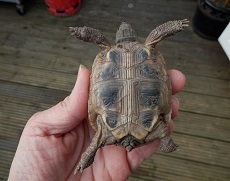General Care
Veterinary Care
Find and register with a veterinary practice in your area that has a good reptile specialist and do this before you actually need them. General vets don't have enough training with reptiles to be able to give best advice, so a specialist is essential.
Monitor weight and length
About once a month use a good set of digital scales and keep a record of your tortoise's weight. This information can be useful for detecting problems with your tortoise and is needed if you attend the vet. For example a substantial increase in weight could indicate a gravid female or weight loss could indicate worms. You will also need to know your tortoise's weight and length when you come to think about hibernation.
The correct way to measure the length of a tortoise is to measure the plastron - not over the carapace. Place a piece of paper on a flat surface so that one end is up against a wall (or other straight firm barrier) place your tortoise on the paper with its head end up against the wall (Your tortoise should have his head pulled right into his shell). Then using a pen mark on the paper where the rear most part of the shell is and then measure. I always find it easier to weigh and measure my tortoises first thing in the morning before they are too warm and active. Otherwise you end up with a tortoise who won't sit still and makes it hard to get accurate measurements when they're constantly trying to wander off.
Check eyes, ears, mouth and nose
Eyes should be open and clear. Any signs of swelling of cloudiness over the eye could indicate an infection and require treatment by a vet.
The ears are located on the sides of the head. Any lumps in this area could mean an abscess in the ear and again requires treatment by a vet.
The mouth and tongue should be pink with no swelling. The easiest way to see a tortoise's mouth is when it opens it wide to eat, so getting down on your hands and knees to look is probably your best option.
The nose should be clear and dry; if there are bubbles appearing from the nose then a specialist vet should be seen immediately as this can be a sign of runny nose syndrome.
Check the shell

A tortoise's shell is made up of two parts. The upper 'domed' part of the shell is the carapace and the flat shell underneath is the plastron. Both should be firm and smooth and not feel at all soft, there should be no cracks or damage to the shell. Any signs of redness need to be investigated by a specialist vet at once.
Bathing
Young tortoises should be bathed daily and adults 2 or 3 times a week to help keep them hydrated. A bowl should be filled with warm water to a depth that just reaches the plastron. Some tortoises may drink from their bath water by fully submerging their heads, you will see a gulping action in the side of their necks as they swallow. Others you may never see drink but they are still absorbing water through their cloaca.
Tortoises will often urinate in their bath water and this often contains a milky white substance called urates. It looks a little bit like paint mixed in with water and should be stringy and not solid.